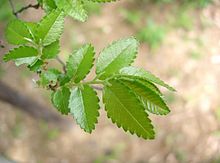Chinese elm
| Chinese elm | ||||||||||||
|---|---|---|---|---|---|---|---|---|---|---|---|---|

Chinese elm ( Ulmus parvifolia ) |
||||||||||||
| Systematics | ||||||||||||
|
||||||||||||
| Scientific name | ||||||||||||
| Ulmus parvifolia | ||||||||||||
| Jacq. |
The Chinese elm ( Ulmus parvifolia ) is a plant from the genus of elm ( Ulmus ).
description
Appearance
The Chinese elm is a deciduous tree that reaches heights of up to 25 meters. The trunk diameter at chest height can be up to 1 meter. The bark is more or less smooth, gray to gray-brown, sometimes merging into olive-green. As it grows thick, the bark tears open into irregular, shield-like scales, which turn brownish-orange. The crown is broadly spherical with branched branches . The branches are long and drooping. In contrast to other elm species, there are no cork wings. The finishing tissue of the branches is brown to very dark brown. The bark of young branches is very hairy, older branches are smooth.
The winter buds are approximately pointed or bluntly ovate to round. The bud scales are reddish-brown to brown and hairy or hairless.
leaf
The leaves are stalked. The 2 to 6 millimeter long petioles are bare or sparsely covered with short hairs. The leaf blades are narrow-elliptical or lanceolate to ovate or obovate. Often they are unequal in length and width on either side of the midrib with a sloping base. They are on average 4.5 inches long and between 1.5 and 2.5 inches wide.
The leaf margin is irregularly serrated with blunt teeth, rarely double serrated. The tip of the leaf is sharp or blunt. The leaf surface becomes paler and hairier with increasing distance from the midrib, dark green, hairless and shiny towards the axis. However, the trichomes fall off as the leaf ages and are only retained on the midrib. The central rib is indented, from it branch 10 to 15 side ribs on each side, each of which forks at least five times.
Inflorescence and flower
The flowering period lasts from August to October. The tufted, trugdoldigen inflorescences contain three to six flowers. The flower stalks are 8 to 10 millimeters long and hairy.
The hermaphrodite flowers have a simple flower envelope . The four identical, reddish-brown, bald bracts are fused together like a funnel. They are deeply lobed four to five times. The three or four stamens carry reddish anthers . The scar is lobed and hairy white. It extends out of the perigone and bends and opens with maturity.
Fruit and seeds
The fruits are winged, single-seeded nuts (samaras) with a greenish to light brown color, rarely also dark brown or reddish. They sit on 1 by 3 millimeter long stalks. The fruits are elliptical and 10 to 13 millimeters long and 6 to 8 millimeters wide. They are notched at the tip and hairless except for remaining white scar hair in the notch. The seed sits in the center or at the tip of the nut.
Chromosome set
The number of chromosomes is 2n = 28.
distribution
The natural distribution area of the Chinese elm is in the People's Republic of China , where it is found at altitudes of up to 800 meters in the provinces of Anhui, Fujian, Guangdong, Guizhou, Hebei, Henan, Hubei, Hunan, Jiangsu, Jiangxi, Shandong, Shaanxi, Sichuan and Zhejiang and the Guangxi Autonomous Region. The Chinese elm is also native to Taiwan . Outside of China, it can of course be found in parts of India and Vietnam , Kazakhstan, as well as in North Korea and Japan .
In North America, neophytic occurrences are found in the United States. The Chinese elm seems to be more easily naturalized than the English elm ( Ulmus procera ) or the mountain elm ( Ulmus glabra ). In Namibia , too, neophytic occurrences can be found around the capital Windhoek ; there this species is considered to be invasive .
The Chinese elm has only been cultivated in Europe for a few decades and is rarely found. It was introduced in Great Britain in 1974.
use
The Chinese elm is valued as a solitary tree in culture because of its beautiful shape and decorative bark. In addition, the species is relatively resistant to Dutch elm disease. The species is also very popular as a bonsai .
The wood has an average density of 910 kg / m³ and a wood moisture of 15%. The leaves and unripe fruits can be eaten raw or cooked. The plant is also said to have medicinal benefits.
Similar Art
The Chinese elm is similar to the Siberian elm ( Ulmus pumila ). Distinguishing features are the smaller, shorter-stalked and only single-toothed leaves of the Chinese elm; those of the Siberian elm are double-serrated. In addition, the flowering time of the Siberian elm is much earlier.
swell
- Liguo Fu, Yiqun Xin & Alan Whittemore: Ulmaceae : Ulmus parvifolia , p. 9 - online with the same text as the printed work , In: Wu Zhengyi, Peter H. Raven & Deyuan Hong (eds.): Flora of China , Volume 5 - Ulmaceae through Basellaceae , Science Press and Missouri Botanical Garden Press, Beijing and St. Louis, 2003. ISBN 1-930723-27-X
- Susan L. Sherman-Broyles: Ulmus : Ulmus parvifolia - same text online as the printed work , In: Flora of North America Editorial Committee (Ed.): Flora of North America North of Mexico , Volume 3 - Magnoliidae and Hamamelidae , Oxford University Press, New York and Oxford, 1997. ISBN 0-19-511246-6
Individual evidence
- ↑ a b Alan Mitchell, translated and edited by Gerd Krüssmann: The forest and park trees of Europe: An identification book for dendrologists and nature lovers . Paul Parey, Hamburg and Berlin 1975, ISBN 3-490-05918-2 .




